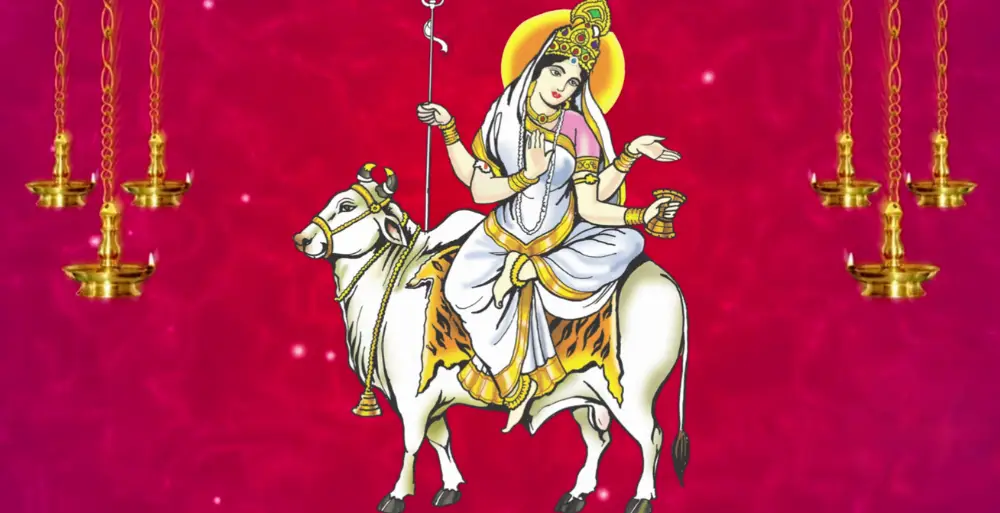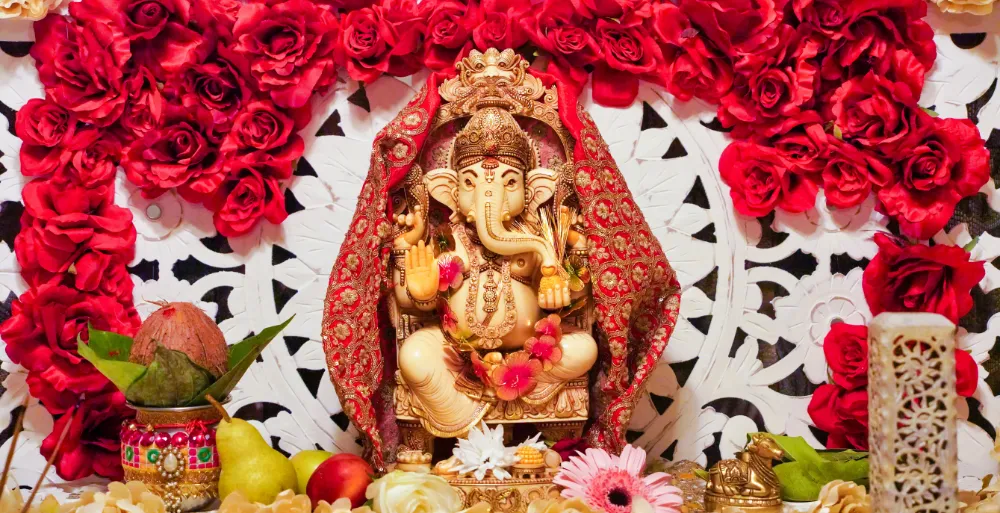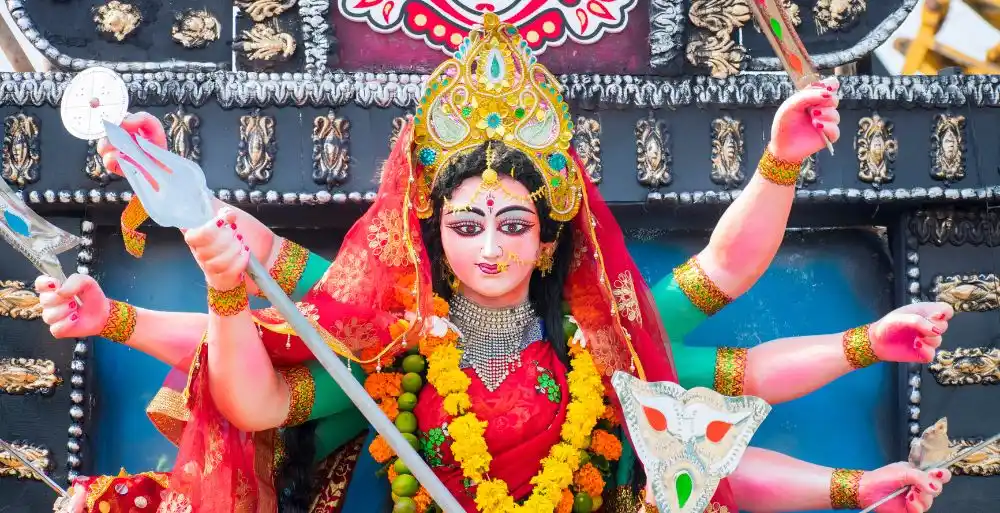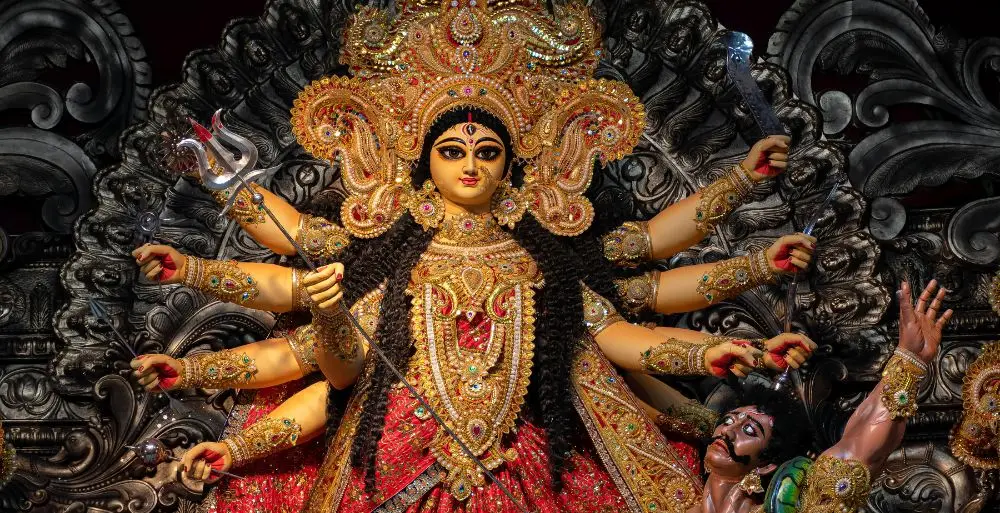Navratri is a nine-day festival honoring Goddess Durga, with each day representing one of her nine forms. The 8th day of Navratri, known as Ashtami, is one of the most significant days of the festival, where devotees celebrate the form of Mahagauri, the eighth avatar of Durga.
This day holds great spiritual importance and is often observed with grandeur and deep devotion. Let’s delve into the customs, significance, and ways to celebrate this divine day.

The Legend of Mahagauri

According to Hindu mythology, Mahagauri represents cleanliness, calmness, and serenity. Her name means “very white,” highlighting her light skin. After a long period of intense devotion to Lord Shiva, the goddess’s skin darkened from the harsh forest conditions. Moved by her faith, Lord Shiva washed her in the sacred Ganges, restoring her original white glow. Thus, she is called Mahagauri, a manifestation of Durga representing cleanliness and simplicity.
Mahagauri is commonly shown on a bull, wielding a trident and a tambourine. She wears white clothes, further emphasizing her cleanliness. The 8th day of Navratri is a day dedicated to praying to this aspect of the goddess for good fortune, a pure heart, and freedom from pain.
Also Read: 1st Day of Navratri: Goddess Shailputri Worship Guide

Significance of Maa Mahagauri Puja on the 8th Day of Navratri
On the eighth day of Navratri, also referred to as Ashtami, devotees honour the victory of Goddess Durga over the powerful buffalo demon Mahishasura. Praying to Goddess Durga on this occasion is believed to purify one’s issues and sins, while also bringing good fortune and luck.
On Ashtami, followers engage in fasting and carry out various ceremonies. They begin by offering prayers to the Kalash to call upon celestial deities and to seek the favour of Goddess Durga’s relatives. In line with the other Navratri days, followers recite all the verses of ‘Durga Saptashi’ to invoke the Goddess’s sacred blessings. Moreover, they perform a special Mahagauri puja mantra to seek the protection of Mahagauri.
Also Read: 2nd Day of Navratri: Worship Guide for Maa Brahmacharini

Kanya Puja: The Heart of Durga Ashtami Celebrations

The Kanya Puja is a key part of Navratri on the 8th day, where devotees worship nine young girls who symbolize the nine forms of Goddess Durga. These girls are seen as divine incarnations, and people offer them special food, gifts, and sweets. This ritual celebrates the power of femininity and is a way to ask for blessings from the goddess.
During Kanya Puja, devotees welcome young girls into their homes, showering them with care and gifts. They serve traditional food like puri, halwa, and chana with deep devotion. After the meal, the girls receive thanks and small gifts as a sign of the goddess’s blessings.
Also Read: 3rd day of Navratri: Goddess Chandraghanta Worship Guide

Rituals and Customs of the 8th Day of Navratri

Devotees observe various rituals on the 8th day of Navratri, including:
Fasting and Devotion: On Ashtami, many devotees observe fast. The fast can be nirjala (without water) or with the consumption of only specific foods like fruits, milk, and non-grain items. The purpose of this fast is to purify both the body and mind and to show devotion to Mahagauri.
Devotees wake up early, take a bath, and adorn their homes with flowers and holy symbols. They then set up an altar or temple at home, placing a picture or idol of Mahagauri on it. The day begins with an invocation to the goddess, followed by offerings of flowers, fruits, incense, and prayers.
Chanting Mantras: Chanting mantras and singing devotional songs (bhajans) are integral parts of the 8th-day rituals. The Mahagauri mantra is one of the most powerful prayers recited on this day.
- The mantra “या देवी सर्वभूतेषु माँ गौरी रूपेण संस्थिता” is believed to bring happiness and prosperity
- The mantra “श्वेते वृषे समरूढा श्वेताम्बराधरा शुचिः” is believed to bring prosperity and good health
Chanting these mantras with sincerity and devotion is said to invoke the goddess’s blessings and help fulfill desires.
Aarti and Bhajans: Devotees perform a special aarti in honour of Mahagauri, accompanied by the singing of bhajans (devotional songs). Aarti is performed with oil lamps (diyas) and offerings of sweets and coconuts to the goddess. Devotees believe that participating in this prayer service will help cleanse their minds of impurities and bestow spiritual clarity.
Also Read: 4th Day of Navratri: Goddess Kushmanda Worship Guide

Colour of the 8th Day of Navratri
Every day during Navratri is linked to a particular colour, and the 8th day is distinguished by the colour pink. Pink represents optimism, warmth, and love that transcends all boundaries. On this day, followers wear pink clothes as a sign of love and benevolence. It’s thought that wearing pink colour gives a serene and uplifting environment, enabling a deeper connection with the goddess.
Also Read: 5th Day of Navratri: Maa Skandamata Worship Guide

Regional Variations of Durga Ashtami
Across India, people observe Durga Ashtami in various ways, with rituals and traditions varying by region:
West Bengal: In West Bengal, the 8th day of Navratri signals the start of the elaborate celebrations in the Durga Puja displays, featuring the most impressive ceremonies like Sandhi Puja. This ceremony occurs at the intersection of Ashtami and Navami, a time regarded for its profound spiritual power.
North India: In North India, people celebrate Durga Ashtami with great enthusiasm. People gather at temples to offer their prayers and take part in the elaborate Kanya Puja ceremonies. In certain areas of Uttar Pradesh and Bihar, there are processions with the Goddess Durga’s idols, where followers sing praises and perform sacred dances.
South India: In South India, particularly in Karnataka and Andhra Pradesh, people observe the 8th day of Navratri with Ayudha Puja. People offer prayers to their tools and instruments, expressing gratitude for their work. They believe that Goddess Durga blesses these tools, bringing prosperity.
Also Read: 6th Day of Navratri: Celebrating the Triumph of Goddess Katyayani

Conclusion:
The 8th day of Navratri, dedicated to Mahagauri, is a day filled with devotion, rituals, and joy. It is a celebration of purity, feminine power, and the blessings that come from self-discipline and faith. By honouring the goddess on this auspicious day, devotees seek to remove negativity from their lives and embrace the purity that Mahagauri represents.
This day not only strengthens spiritual connections but also reinforces the importance of purity, devotion, and humility in daily life. Whether through fasting, Kanya Puja, or simply wearing the colour pink, celebrating the 8th day of Navratri allows us to experience the divine grace of Mahagauri.





